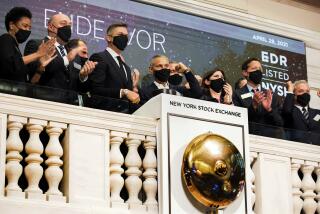Telescope maker Meade Instruments at a turning point
- Share via
Directors of Meade Instruments Corp., which has helped foster the consumer market with its easy-to-use telescopes and binoculars since 1972, may be tipping their hand by Monday on whether to recommend selling the company, plow ahead alone or possibly seek bankruptcy protection.
The Irvine company, fighting a sharp drop in sales, is weighing two buyout offers, one from a Chinese company and another from a San Jose venture capital firm. Meade said that if the deals are rejected, the company may opt to file a bankruptcy petition.
Whatever directors decide, it could be the end of an era for a company that once produced one of the more popular lines of telescopes for consumers and withstood an industry shake-up — only to be crushed in the economic downturn.
Meade hasn’t turned a quarterly profit since May 2008. In its latest fiscal year, which ended Feb. 28, the company reported a net loss of $3.7 million.
The company’s problems mirror the industry as a whole, which has been plagued in recent years by tighter spending and changing consumer tastes.
Kids who once put telescopes at the top of their birthday and holiday wish lists are now opting for high-tech gadgets. People no longer hold stargazing parties, and households that once proudly displayed their telescopes no longer think they are trendy, analysts said.
“They used to be cool among the younger demographic, but kids are interested in other things besides constellations,” said Deonta Smith, an industry analyst at research firm IBISWorld Inc. “The decline has been clear over the last 10 years. The market is shrinking.”
That slowing demand already has pushed the industry to consolidate as companies sought to cut costs and streamline operations.
Celestron International in Torrance, which almost merged with Meade in 2002, was acquired by a Taiwanese maker of astronomy equipment in 2005. In 2004, Meade bought smaller rival Coronado Technology Group.
Now, Meade is the takeover target.
In mid-May, Meade supplier Jinghua Optics & Electronics Co. in Guangzhou, through its U.S. subsidiary, offered to buy the company for $3.45 a share, nearly a 100% premium over Meade’s $1.74 closing price the previous day. Jinghua already had purchased Meade’s European unit.
But shareholders didn’t think the price was high enough, and three law firms said they were looking into whether the board failed to look for better offers. Meade’s stock shot up in expectation of higher bids.
In mid-June, San Jose venture capital firm MIT Capital Inc., using its VictoryOne subsidiary, offered $3.65 a share, an 18-cent premium over the previous day’s closing stock price.
MIT Capital also disclosed that it had been bidding on Meade since February and that a May 8 proposal offering $3.50 a share was twice the previous day’s closing price of $1.75 for Meade stock.
Meade shares gained 68 cents Wednesday to close at $4.40.
Meade’s directors said they plan to disclose by Monday their recommendation on which bid to take — or whether to remain neutral or even file for bankruptcy protection instead — in a filing with the Securities and Exchange Commission.
In financial documents, the company has raised the possibility of bankruptcy if no buyer is found. A new owner probably would sell products under the Meade name and play up its cachet in the telescope industry, analysts said.
Meade pioneered several technological advancements in the telescope industry, such as the first “go to” telescope for the commercial market, which included a computer that would automatically find, focus on and track celestial objects at the user’s instruction.
The company still makes telescopes that range in price from less than $100 to as much as $35,000 and binoculars costing $100 to $300.
Even if a buyer can be found, Meade still must compete in a diminishing market for telescopes, analysts said.
Astronomy buffs increasingly have turned to smartphone apps that give users the feel of exploring the skies without “investing hundreds of dollars in a telescope,” said Jock O’Connell, an economist with Beacon Economics.
Such apps enable users to view the sky from anywhere in the world on their screens without the fuss of figuring out how to work and carry a bulky gadget.
“The apps perform some of the same functions as a telescope would, but they are easier to use,” IBISWorld analyst Smith said. “If you are a novice user you don’t have to learn how to chart sky coordinates.”
The U.S. telescope market has shrunk, on average, 2.9% annually in the last five years. The sector pulled in $126.7 million last year, compared with $147.4 million in 2008, according to IBISWorld.
Meade sales have fallen sharply, to $22 million last year from $102 million in fiscal 2007.
Wall Street analysts backed away from covering Meade as the company’s losses piled up. One report last year from Wright Investor Service in Milford, Conn., said that the company was doing so poorly that “theoretically, the net value of the assets is greater than the value of the company as a going concern.”
If Meade survives, one bright spot may be future exports. Europeans recently developed a taste for telescopes, thanks to the popularity of the British astronomy show “Stargazing Live” and the appeal of its host, a handsome professor.
Amazon.co.uk, the British arm of the retail giant, told reporters that telescope sales jumped nearly 500% in Britain after the TV show’s first episode in January.
More to Read
Inside the business of entertainment
The Wide Shot brings you news, analysis and insights on everything from streaming wars to production — and what it all means for the future.
You may occasionally receive promotional content from the Los Angeles Times.












